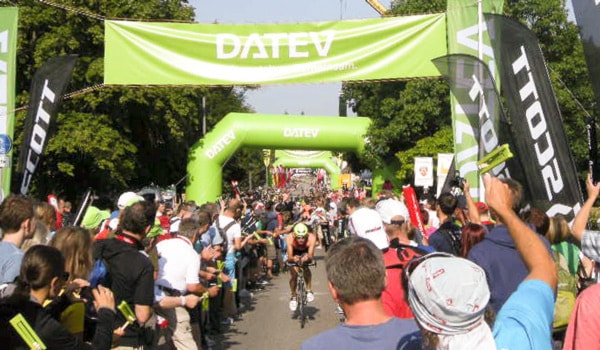It’s going to be a few years before Challenge Penticton builds to the same level of participants and spectators that the city enjoyed after 30 years of Ironman, but a delegation who just returned from the Challenge race in Roth, Germany say there is no lack of potential for the new race.
“There were around 200,000 visitors with 5,600 athletes at this race. If you think about the proportion of visitors that are coming, it’s pretty substantial,” said Tracy Reis of Tourism Penticton, noting that Roth actually only has two accommodators in town.
“The fact it is such a huge tourist draw to the area and people are willing to stay outside the community to experience this event tells you how fantastic it is and what the potential is for us to replicate that.”
Roth is not just about the race, according to Colleen Pennington, Penticton’s economic development officer, who was also part of the delegation, which also included representatives from city hall, Challenge Penticton and a variety of community sectors.
“It is about a good race experience for the athletes, but Roth is about community engagement in a tourism event,” said Pennington. “That is why they get 200,000 people out. The race experience is fantastic, but the street experience is as fantastic.”
As an example, Pennington uses Hilpostein, a small town on the bike route containing one of the race’s major hills.
“It’s a tiny little place, but there are 30,000 people on the hill where the bikers come through, having a street party,” said Pennington.
“People want to go for the experience of the race in the context of that celebration.”
As Pennington describes it, more than just the local tourism board is involved. That is the key differentiator between what Ironman was and what Challenge is in Europe.
Participation ranges from title sponsors all the way down to simple table talkers at a pizzeria, with a little story about a race athlete on one side and specials on the back.
“This is really the communities’ race. It’s really a race that people can take ownership of. So businesses in the community, residents can really take ownership of it,” said Reis. “Because it is brand new here, we get the opportunity to shape it however we like.”
“That is exactly analogous to what Oliver and Osoyoos could be doing,” said Pennington. “And they do a little bit in the aid stations, that’s always been part of the heritage. It was that on steroids. There was a reason to go out just for the street party.”
While the first year of Challenge Penticton is unlikely to bring out the numbers of spectators they saw in Roth, Pennington said businesses and communities can start laying the groundwork for future growth.
“I think this year what we need to do is run a fantastic race for the athletes. That is the foundational layer. We want the inaugural year of challenge to be a great race for the athletes,” said Pennington.
From a business perspective, she recommends making sure the athletes and spectators know they are welcome.
“Whatever little things you can do to connect the fact that the business is aware these people are coming to our communities, riding through them and they are going to tell their stories,” said Pennington. “You can go from as little as a simple promotional item to the maximum of title sponsor. What was important was to send out the message that you are welcome, we want you in our community, it’s important.”
“It’s a tremendous opportunity to show how the whole valley is engaged in creating a great experience for the athletes and the visitors, directly or indirectly,” said Pennington. “As we look at that over time, we need to look at what Germany has done and figure out how we make it an iconic Okanagan experience with the same feel.”
Those subtle differences around the athlete experience combined with showing a welcoming attitude, making it a celebration and getting involved, Pennington said, were key.
“Those were the core things that I think we are doing some of, but we can build on and create a much more experiential race both for the athlete, but as important, for the spectator,” said Pennington. “Those are the pieces I would like to see us leverage. People deal with people they have relationships with, and it is that relationship value you are building when you invest in something that has no direct monetary value.”
